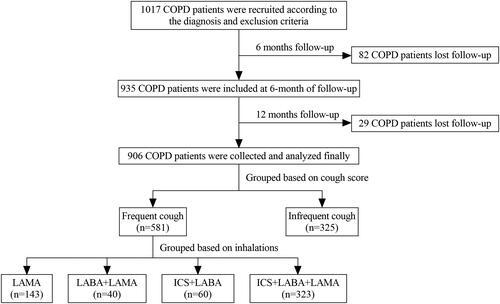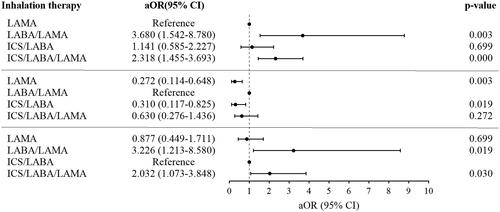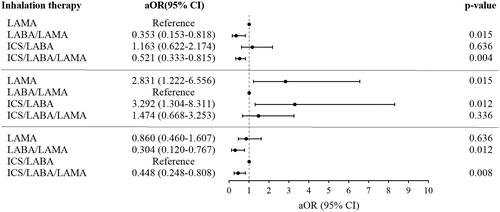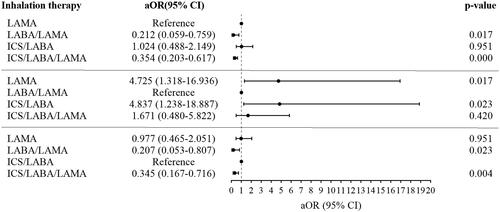Figures & data
Figure 1. Flow chart of the study.
A total of 1017 patients with COPD were enrolled at the baseline visit. Eighty-two patients were lost to follow-up during the 6 months interval. Twenty-nine patients were lost to follow-up at the 12th month visit. Finally, we recruited 906 patients with COPD for our analysis, including 581 patients with frequent cough and 325 patients with infrequent cough.
Abbreviations: COPD: chronic obstructive pulmonary disease; LAMA: long-acting antimuscarinic; LABA: long-acting beta2-agonist; ICS: inhaled corticosteroids.

Table 1. Baseline clinical characteristics of COPD patients with different cough score.
Table 2. Multivariate logistic regression for factors related to frequent cough in COPD patients.
Table 3. The relation between cough and clinical outcomes during the follow-up in COPD patients after PSM.
Figure 2. Multiple logistic regression for inhalation treatments correlated with the MCID of CAT in patients with frequent cough during 6 months follow-up.
Note: Age, sex, exacerbations in the past one year, FEV1%pre, CAT total, mMRC, cough score and inhalation therapies were included in the multiple logistic regression model.
Abbreviations: LAMA: long-acting antimuscarinic; LABA: long-acting beta2-agonist; ICS: inhaled corticosteroids; OR: adjusted odds ratio; CI: confidence interval.

Figure 3. Multiple logistic regression for inhalation treatments correlated with the moderate/severe exacerbations in patients with frequent cough during 12 months follow-up.
Note: Age, sex, exacerbations in the past one year, FEV1%pre, CAT total, mMRC, cough score and inhalation therapies were included in the multiple logistic regression model.
Abbreviations: LAMA: long-acting antimuscarinic; LABA: long-acting beta2-agonist; ICS: inhaled corticosteroids; aOR: adjusted odds ratio; CI: confidence interval.

Figure 4. Multiple logistic regression for inhalation treatments correlated with the frequent exacerbations in patients with frequent cough during 12 months follow-up.
Note: Age, sex, exacerbations in the past one year, FEV1%pre, CAT total, mMRC, cough score and inhalation therapies were included in the multiple logistic regression model.
Abbreviations: LAMA: long-acting antimuscarinic; LABA: long-acting beta2-agonist; ICS: inhaled corticosteroids; aOR: adjusted odds ratio; CI: confidence interval.

Table 4. Comparison of outcomes among different inhalation therapies in COPD patients with frequent cough during the follow-up.
Supplemental Material
Download Zip (267.3 KB)Data availability statement
All publications discussed in the manuscript are available from the corresponding author on request.
